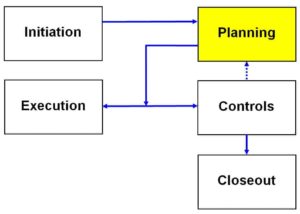Are You Ready to be a Project Manager?

Are you ready to be a project manager? Below is a quiz that builds on the previous project planning articles in this series. Let’s see how much you’ve learned by preparing an outline for a project management plan:
The Situation
You are the property manager for a 200-room hotel in a congested downtown area with narrow streets and alleys. In August, corporate headquarters sends an e-mail to remodel all 200 rooms the next January through April (your slow season at 85 percent occupancy during the week and 60 percent on weekends). Work is to create minimal disturbance to the guests. 40 of the existing rooms are to be converted into 20 suites with kitchenettes. You have until December 15 to have a remodeling company under contract, with work to begin on January 2. Lots of snow will hamper downtown travel and deliveries.
Prepare an annotated outline for a project management plan (from planning through closeout). Note, in this case, your “plan” must include how you will plan for the remodel.
Suggested Outline of the Plan
Determine Requirements: I’m going to assume corporate has done this before, so they must have guidance to provide. Obtain their latest guidance, and points of contact for answering questions. If they have never done this before, I will request a large budget for outside assistance. The output from this effort will be drawings showing which rooms will be converted to kitchenettes, specifications for the conversions and the remaining remodeled rooms, including the details such as where the new walls go, the remainder of the build-out, paint, carpets, furniture, etc. The text in this section of the project management plan (and the others that follow) will explain how all of these activities will be accomplished, in enough detail that if I leave the company, someone else could pick up the document and use it like a cookbook. In reality, corporate should also supply a boilerplate project management plan that would require few revisions on my part.
Develop a Schedule: The schedule will include the remainder of the activities. Leave 2 weeks of contingency time prior to having a contractor hired; give the contractor 2 or more weeks before he must begin work; and leave 2 weeks of contingency time at the end of the project.
Develop a Cost Estimate: Preliminary at this time, and updated when the bids are received. Include costs for the activities before construction begins, and for all of the non-contractor activities during construction.
Inform Department Managers: Inform the managers of maintenance, housekeeping, reservations, restaurants, conventions, and ask them to prepare lists of concerns and recommendations for review within a week. Review their input and meet the next day to discuss only items that need group resolution. Assign committees to address issues that are not quickly resolved and make consensus recommendations. Evaluate and confirm with corporate.
Research Regulatory Requirements: Assign someone to notify the city agencies to identify any requirements corporate does not have (planning and zoning rules; items more strict than the uniform building and fire codes; required permits; winter traffic rules; etc.). If the building pre-dates 1980, conduct an asbestos survey. Investigate presence of other hazardous materials such as PCB, mercury-vapor switches, lead based paint, etc. Catalog results and incorporate into the remainder of the plan.
Architectural-Engineering Design: Hire consultants to determine how moving walls, plumbing, electrical, mechanical systems will impact this particular structure. If necessary, modify the plans and specifications.
Customer Service/Sequencing Plan: Demolition is the biggest concern (noise, dust, hauling debris, possible hazardous waste). Specify the order in which blocks of rooms will be converted and/or remodeled to minimize disturbance to guests. Rooms adjacent, above, below the active work will need to be closed to occupancy. Mobilization/demobilization costs will dictate that demolition crews should not be mobilized several times. Guests should be informed prior to making reservations during this time period what, if any, inconvenience they might expect, and be offered incentives to book a reservation. Develop a list of, and budget for, complimentary items to be offered to customers who will be angry regardless of advance warning. Schedule how the computer reservation system will be updated to reflect the 40 rooms becoming 20 suites with kitchenettes.
Security Plan: Address security of guests, employees, and property related to not only the many workers in the building, but intruders taking advantage of the disruptive situation. Specify any background checks, badges, additional private security personnel.
Quality Plan: Quality reviews of the design. Minimum qualifications for persons performing and overseeing the work. Hiring skilled 3rd party inspectors to observe the work. Develop authorities for stopping substandard work and prescribing corrective action. State when the city building inspectors want to be present.
Special Logistics and Constraints: Working with the city or hiring additional snow removal crews. Just in time delivery of materials and hauling of demolition debris at times that will create minimal traffic disturbance. If asbestos was identified, safe removal and all the issues related to worker protection and preventing migration of asbestos from the work areas. Times of day during which demolition and other activities will be allowed. Obtain permits and/or develop a checklist for permits the contractor must obtain.
Finalize, Advertise, Distribute Bid Package: Reviews of the bid package before it is published, and by whom. Mechanisms to advertise the job to prospective bidders. Distribution by hardcopy, e-mail, or web download.
Pre-Bid Walk Through: When it will occur. Will questions be answered at the meeting, and if so, by whom. Will questions be answered after the meeting, and if so, how will the answers be distributed. Who has the authority to answer which type of questions.
Contractor Selection: Will it be low-bid or low bid of the qualified. Determining the qualified by checking references and possibly interviews. Risk mitigation by ensuring demolition crews or subcontractors are certified to remove asbestos and other hazardous substances. Establishing the contract and approving subcontractors.
Perform the Remodeling: Mainly, observing the contractors and comparing their progress with the sequencing schedule, and doing the things you said in the plan. Daily status meetings with the contractors at first, possibly relaxed to twice per week as long as things are going well. Daily meetings with the 3rd party inspectors you hired. Communications plan should have specified how and when you contact the city building and fire inspectors, and who is responsible. How disputes will be addressed. Status reports to corporate. Reviewing and approving invoices. Creating punchlist of final items on a per room basis, and completing these items so the room can go back into service.
Closeout: Collect warranties of materials and workmanship, operation and maintenance manuals. Final payment and release of liens. Train the maintenance and housekeeping employees. Catalog lessons learned and submit suggestions back to corporate for continuous improvement.
Next Article in This Series: A Project Start-up Checklist.
Category: Business Growth & Strategy Communication & Alignment
Tags:


